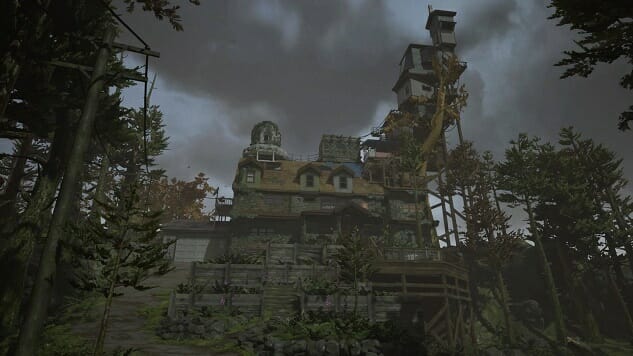What Remains of Edith Finch is a Story Made of Stories

Many great novels have traced families through multiple generations—the Jones and Iqbals of Zadie Smith’s White Teeth; the Sinais of Salman Rushdie’s Midnight’s Children; the Hamiltons and Trasks of John Steinbeck’s East of Eden. Each of these novels finds the totality of its characters not only in their individuality, but in their relationships to parents, siblings, grandparents and, most of all, the effects of the past on the present day.
Giant Sparrow’s What Remains of Edith Finch attempts to translate the purpose of the multi-generational story to videogames. It mainly succeeds. From the viewpoint of 18 year-old Edith, the player returns to her family home, a tall, wobbly-looking mansion nestled within the dense pines of an island off the Washington coast. She’s been left a key to the place by her recently deceased mother and, narrating the journal entry she writes as the game plays out, explains that the last time she’d set foot in the house was years ago. Edith drops a cryptic hint that leaving wasn’t a happy choice. Looking up at the building, the dull tones of its mossy siding and vine-covered roof give the impression that the Finch’s ancestral home is a looming forest ghost—something as old and unknowable as the natural landscape it seems a part of.
Edith Finch makes the complexities of a family physical, representing a myriad of aunts, uncles, grandparents and other limbs of a sprawling ancestral tree with a series of rooms the player enters into by climbing, crawling and squeezing through secret, interconnected passageways. The house is cramped and dimly lit, its hallways narrow and doors shut tight with ominously placed locks and overflowing, hastily-applied caulking. Stacks of books bulge from shelves, food sits discarded and petrified on tables, and over all of it there lies the stillness of an empty museum. The effect of the house, inside and out, is of an artifact discovered perfectly preserved. The remnants of a century of family life remain frozen in time, allowing Edith and the player to read an ancestry like the pages of a book.
Once Edith finds her way into the first locked room, though, her tour of the Finch family tree takes place with far more intimacy than the rest of the house’s dusty still life suggests. She enters her great-aunt Molly’s bedroom—a time capsule tableau of a child’s room. When Edith opens a diary written in Molly’s hand, she finds herself inside the words themselves. Now narrated by the voice of a distant family member, the player follows the young girl’s dream. She becomes a cat, hopping from tree branch to tree branch, then an owl flying above snowy fields to catch rabbits, then a shark hunting seals in murky waters. By the time the player is controlling the outstretched tentacle of a sea monster, snaring sailors and wrestling them back into an unseen maw, Edith Finch has made clear it’s a game where the line between past and present—imagination and reality—bleed into one another.
-

-

-

-

-

-

-

-

-

-

-

-

-

-

-

-

-

-

-

-

-

-

-

-

-

-

-

-

-

-

-

-

-

-

-

-

-

-

-

-









































